Messari: Interpreting the Rise of the Third Generation MEME Coin PEPE
Author: Messari - Chase Devens
Compiled by: BlockTurbo
Key Insights
PEPE has become the fastest-growing ERC-20 token in cryptocurrency history, achieving a market cap of $1 billion and 107,000 holders in just 23 days;
PEPE has sparked a revival of meme coins. Consequently, both the Ethereum and Bitcoin networks have experienced congestion and rising transaction fees;
While PEPE's growth rate has set records, its valuation is still only a fraction of DOGE and SHIB.
A common complaint about the current state of cryptocurrency is its lack of applications for the average person. This is a fair criticism, but one product has consistently proven capable of attracting new users to the blockchain: meme coins. Recently, due to PEPE's parabolic growth, speculators have shown renewed interest in meme coins. PEPE is an Ethereum ERC-20 token that attracted 107,000 holders and reached a market cap of over $1 billion in just 23 days. To better understand the role of meme coins in cryptocurrency, let's look at their history and evolution, culminating in the recent market frenzy surrounding PEPE.
Origins
The origins of meme coins can be traced back to Dogecoin (DOGE) at the end of 2013, peaking during the bull market of 2021. In 2021, DOGE gained mainstream popularity, growing from a market cap of $700 million on January 1 to $88 billion by early May. Following the Dogecoin craze, Shiba Inu (SHIB) reached a market cap of $42 billion by the end of October, having started the year with a market cap of less than $1 million. These dog-themed assets have no intrinsic value, but their association with viral internet memes has propelled their popularity among cryptocurrency users and retail investors.
Now, PEPE is the latest meme coin to capture market attention. The coin's popularity stems from the character Pepe the Frog, created by Matt Furie in his 2005 cartoon "Boys Club." After the original Pepe artwork and its later variations went viral on internet platforms like 4chan and Tumblr in the 2010s, Pepe was embraced by the cryptocurrency community and quickly became part of cryptocurrency culture lore.

The PEPE token was launched over three weeks ago on April 14, with a total supply of 420.69 trillion tokens. Of these, 93.1% were deposited into Uniswap's liquidity pool, while the remaining 6.9% were stored in a multi-signature wallet for future centralized exchange listings. The anonymous team behind PEPE leveraged the existing popularity of Pepe the Frog on Twitter and created a meme campaign to drive early adoption. This strategy can be said to have achieved unexpected success.
PEPE Growth Data
PEPE's rapid growth is unprecedented in cryptocurrency history. Its first two days were relatively calm, but by the third day, the number of holders was increasing by the thousands each day. PEPE achieved over 100,000 holders on-chain in just 22 days.
This is even more impressive compared to the historical growth of other rapidly growing Ethereum tokens. When SHIB entered its hyper-growth phase in 2021, it still took 90 days to reach 100,000 holders. Viral assets from the DeFi summer of 2020, such as YFI and YAM, never even reached the milestone of 100,000 holders. As a benchmark for more organic growth rather than speculative demand, Dai took 225 days to reach 100,000 holders.
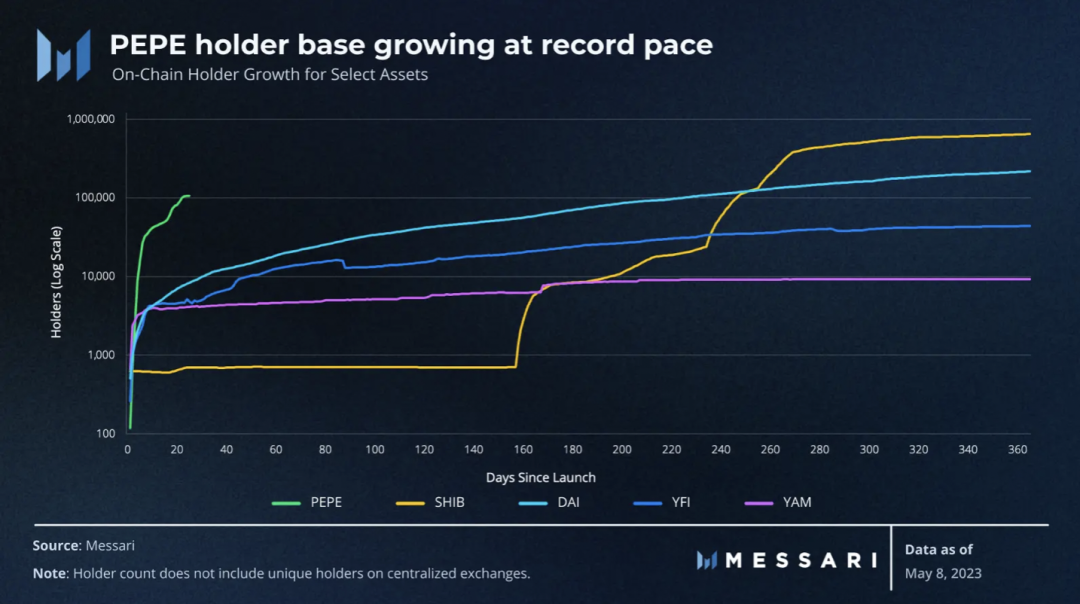
It can be argued that the most important factor driving PEPE's growth is that cryptocurrency participants are now familiar with how meme coins can grow rapidly, as seen in the initial cycle led by DOGE and SHIB in 2021. Getting in early can be profitable, and this self-reinforcing power attracts more buyers as meme popularity increases.
If we look at the average value per holder for PEPE and SHIB, measured by the market cap held by each holder, we find that PEPE shows a similar growth pattern to SHIB but at a much faster pace.
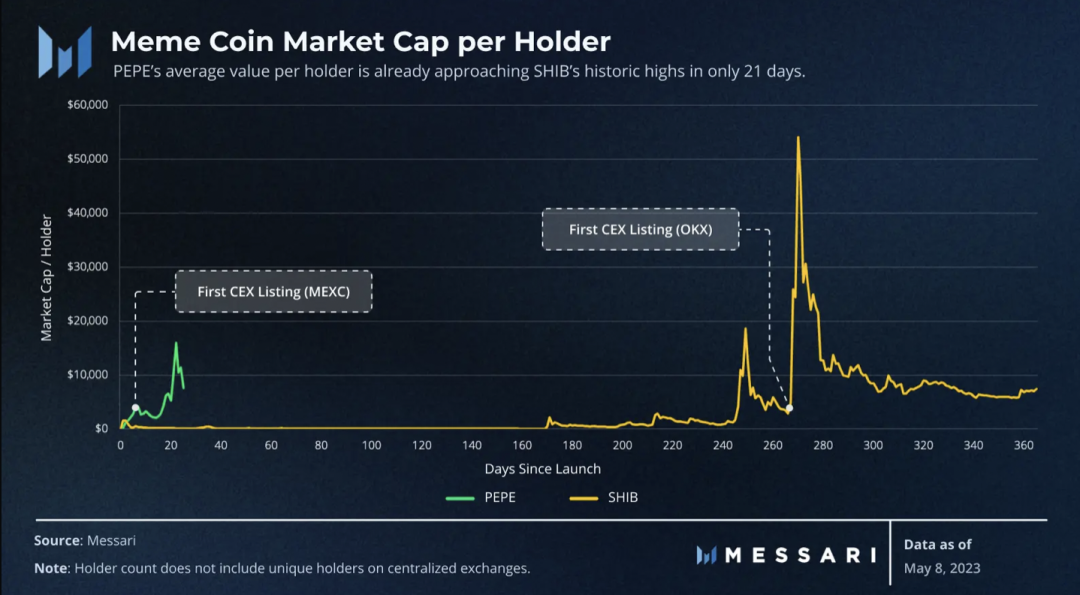
The rapid listing on centralized exchanges fueled PEPE's hot start. PEPE was listed on MEXC, its first centralized exchange, in just six days, and within 22 days, it was listed on Binance, the world's largest cryptocurrency exchange. These integrations not only lowered the barrier for user speculation but also enabled large capital providers to offer off-chain market-making services. In the past week, we have seen most of PEPE's trading volume shift from Uniswap to these centralized platforms.
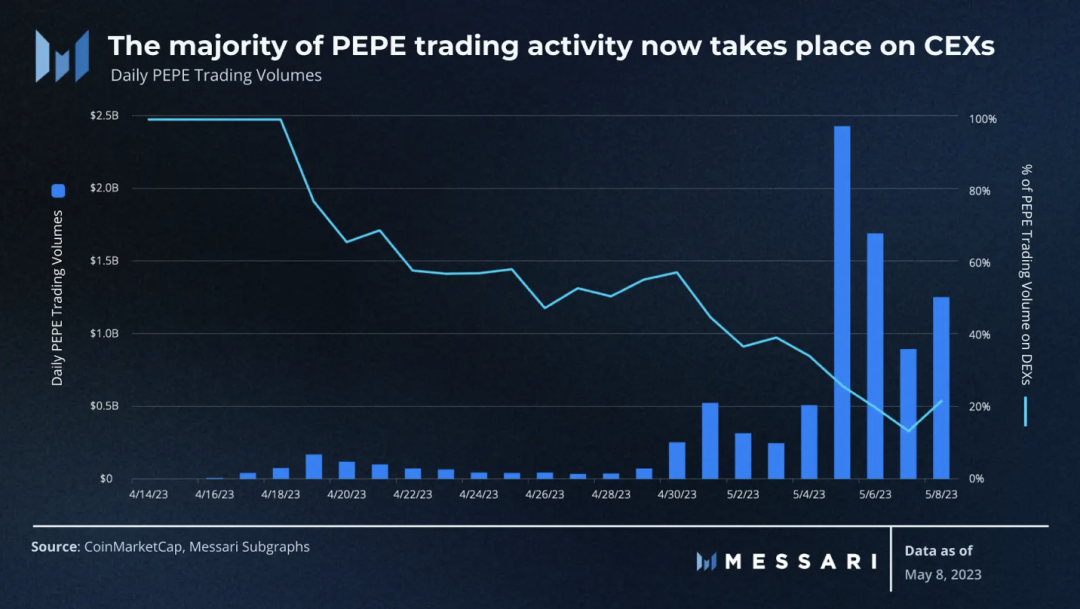
The adoption of PEPE on centralized exchanges has also opened the door for PEPE derivatives trading. Now, exchanges like Binance and Bybit offer PEPE perpetual futures, allowing users to invest in PEPE's price with 100x leverage. In just a few days, the trading volume of PEPE derivatives has surpassed that of daily spot trading.
Since derivatives create leveraged exposure to the underlying asset, they also bring greater volatility to the asset. This volatility is now spilling over into Ethereum's DeFi ecosystem, where significant price fluctuations of PEPE over the weekend drove Ethereum gas fees to annual highs. Users are once again facing the need for transaction fees exceeding $100 to swap PEPE on-chain.
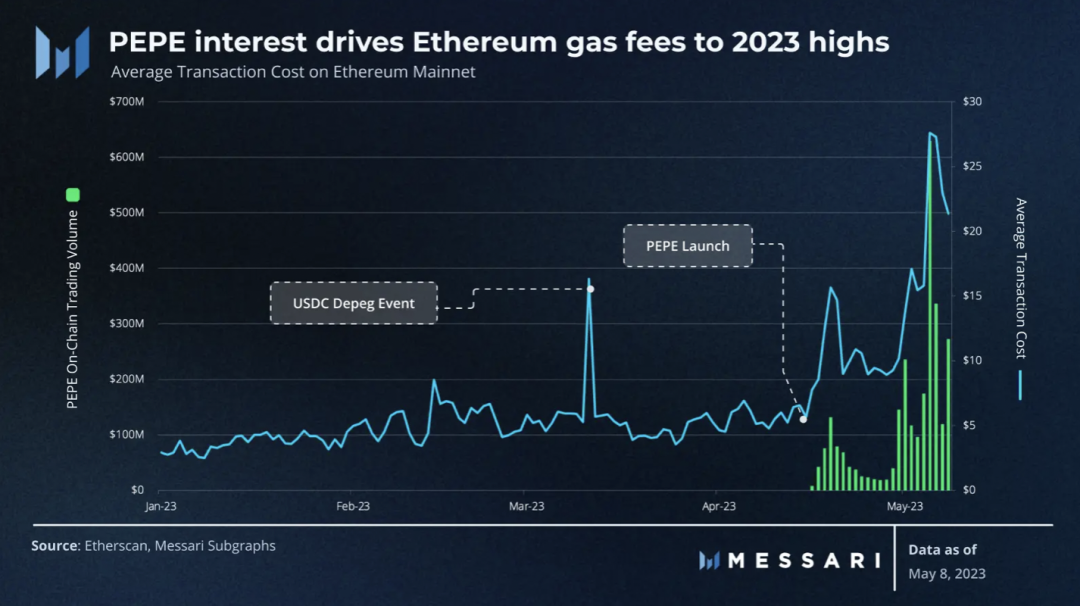
Unlike the meme coin frenzy of 2021, the Ethereum ecosystem now has well-developed Layer 2 solutions that can help alleviate mainnet congestion. However, the creators of PEPE chose to launch on the Ethereum mainnet to maximize their exposure to liquidity.
While Ethereum, Arbitrum, and Polygon all offer a similar number of daily active users, Ethereum's total locked value is $29 billion, Arbitrum's is $2.5 billion, and Polygon's is $1 billion. Choosing to launch on Ethereum's scaling solution would create greater friction and reduce the likelihood of a PEPE explosion.
Meme coins may not have shone brightly on Ethereum's scaling solutions, but they are expanding into Bitcoin through the novel BRC-20 standard built on the Ordinals protocol. These "tokens" are fungible batches of metadata inscribed in a single satoshi on the Bitcoin network. Since the launch of PEPE, BRC-20 meme coins have exploded in popularity, causing significant congestion on the network—enough to force Binance to suspend BTC withdrawals twice in one day to reconfigure their fee processing.
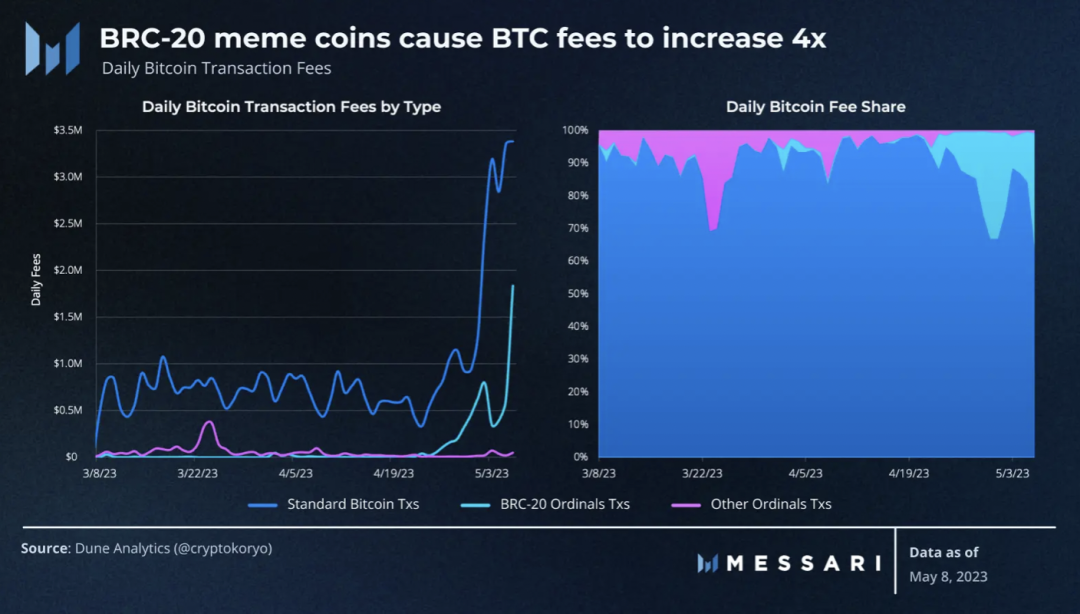
Finally, the resurgence of activity on the Ethereum mainnet has benefited ETH holders. Since The Merge in September 2022, the supply of ETH has been shrinking at an unprecedented rate. While on the surface, PEPE is clearly the standout winner of the recent meme cycle, the "Ultrasound Money" meme has shown its strength in the fundamentals.
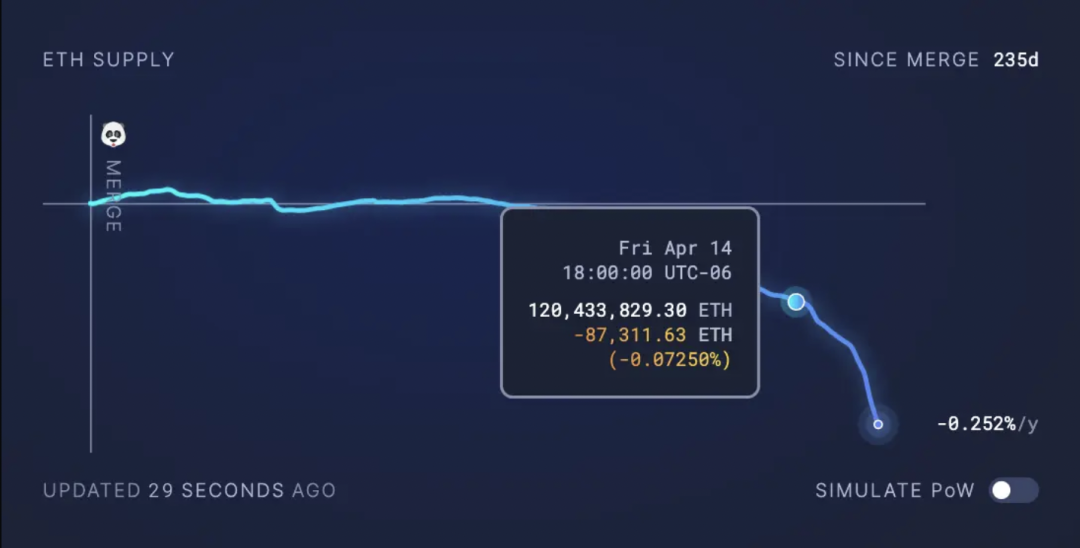
Looking Ahead
Both SHIB and DOGE experienced a 90% price correction after their parabolic growth in 2021. Will PEPE face the same fate? History in the speculative market would suggest so. However, this does not mean that PEPE's rise is over.
During the peak of the frenzy in October 2021, SHIB's market cap briefly surpassed DOGE, reaching a high of $45 billion. With a market cap of $1 billion, PEPE is currently one-fifth of SHIB's market cap and one-tenth of DOGE's market cap. It would not be surprising to see it exceed either of these at some point, even if only briefly.
Another data point worth noting is the daily active users on Uniswap on Ethereum. This number has more than doubled since the launch of PEPE and is now rapidly approaching the historical high of 90,000 daily users from May 2021. The integration of Uniswap's mobile wallet has improved since 2021, and if PEPE's attention continues to grow, it may set new daily user records.
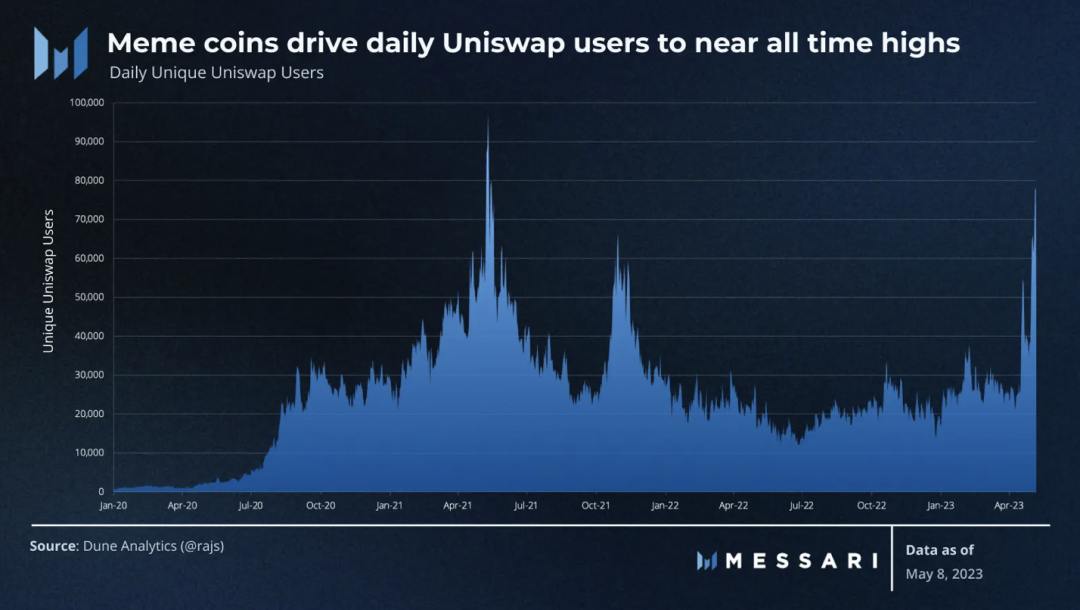
Finally, stories of early PEPE buyers becoming wealthy through small initial investments are spreading. These stories make it more attractive for marginal users to speculate on other newly launched meme coins. In the first two weeks following PEPE's launch, we began to see substantial interest in other meme coins like WOJAK, TURBO, and AIDOGE. However, the excitement and growth of these alternative meme coins are characteristic of the final stages of the 2021 meme coin frenzy.









